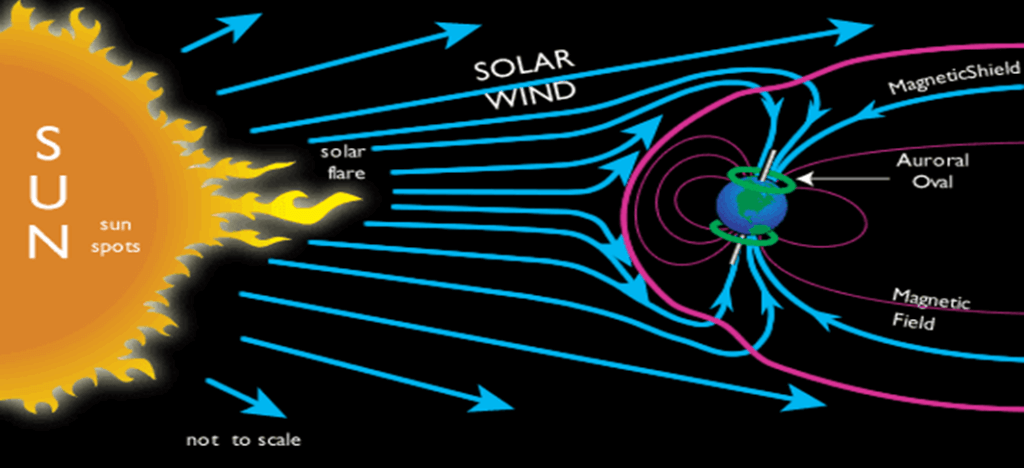Recently, the Indian Astronomical Observatory situated over Mount Saraswati in Hanle, Ladakh, India, captured stunning aurora lights on its camera. The auroras were observed due to an intense geomagnetic storm that hit Earth, resulting in mesmerizing auroras in several regions of the Earth.
What are ‘Auroras’?
Auroras, also known as aurora borealis or northern lights near the North Pole and aurora australis or southern lights near the South Pole, are a natural phenomenon caused by magnetic storms initiated by the Sun’s activity, such as solar flares and coronal mass ejections. Auroras are visible as bright lights in the sky and are usually seen in regions closer to the Earth’s poles due to weaker magnetosphere. During strong solar storms, auroras can be visible further away from the poles.
How Do Auroras Form?
The Sun constantly emits a solar wind composed of charged particles that flow outward into the solar system. When the solar wind encounters the Earth’s magnetic field, it can trigger a process called magnetic reconnection, which allows charged particles from space to be accelerated into the atmosphere. The charged particles from the solar wind are guided around the Earth’s magnetosphere and eventually become trapped in the magnetosphere’s long tail. When magnetic reconnection occurs, these particles are accelerated towards the Earth’s poles.
Along the way, particles may collide with atoms and molecules in Earth’s upper atmosphere, providing the atoms with extra energy that is released as a burst of light. When we see the glowing aurora, we are witnessing a billion individual collisions that light up Earth’s magnetic field lines.

Why Are Northern Lights Visible Only in Winters?
During the winter, the northern regions have long periods of darkness, making it easier to see the Northern Lights. In the summer, the polar regions have nearly continuous daylight, making observation difficult.
Solar Phenomena Which Caused Auroras in Ladakh
The Sun released a coronal mass ejection towards Earth, which was linked with an M1 solar flare. A coronal mass ejection is a large expulsion of plasma and magnetic field from the Sun’s corona, and it travels outward from the Sun. Solar flares are flashes of light that occur on the Sun in various wavelengths.
When magnetic energy is released from sunspots, intense bursts of radiation, or solar flares occur. The auroras were observed in lower-than-usual latitudes. The last time such a severe geomagnetic storm occurred was in 2015, and the event resulted in rare sightings of auroras in Europe, China, and Ladakh.
Important Points:
🌌 Auroras are a natural phenomenon caused by magnetic storms initiated by the Sun’s activity such as solar flares and coronal mass ejections.
🌎 They are visible as bright lights in the sky and are known as aurora borealis or northern lights near the North Pole and aurora australis or southern lights near the South Pole.
🔭 Typically, auroras are seen in regions closer to the Earth’s poles due to weaker magnetosphere, but during strong solar storms, they can be visible further away from the poles.
🌞 The Sun constantly emits a solar wind, which is composed of charged particles and flows outward into the solar system.
🔮 When the solar wind encounters the Earth’s magnetic field, it can trigger a process called magnetic reconnection.
🌠 The charged particles from the solar wind are guided around the Earth’s magnetosphere and eventually become trapped in the magnetosphere’s long tail.
💥 When magnetic reconnection occurs, these particles are accelerated towards the Earth’s poles.
💫 Along the way, particles may collide with atoms and molecules in Earth’s upper atmosphere, providing the atoms with extra energy that is released as a burst of light.
🌃 During the winter, the northern regions have long periods of darkness, making it easier to see the Northern Lights.
☀️ In the summer, the polar regions have nearly continuous daylight, making observation difficult.
🌟 The Sun released a coronal mass ejection towards Earth, and it was linked with an M1 solar flare.
🔔 A coronal mass ejection is a large expulsion of plasma and magnetic field from the Sun’s corona, and travels outward from the Sun.
🌄 Solar flares are flashes of light that occur on the Sun in various wavelengths.
🌏 The auroras were observed in lower-than-usual latitudes, specifically in Ladakh, India.
🔮 It is extremely rare to see auroras at latitudes as low as those of Ladakh.
🌍 The last time such a severe geomagnetic storm occurred was in 2015, and that the event resulted in rare sightings of auroras in Europe, China, and Ladakh.
Why In News
The Indian Astronomical Observatory located over Mount Saraswati in Hanle, Ladakh, India, captured mesmerising aurora lights caused by a rare geomagnetic storm that hit Earth. This is a significant event, as auroras are typically seen only in high-latitude regions near the Arctic and Antarctic circles, making it extremely rare to observe them at latitudes as low as those of Ladakh. The observation provides a unique opportunity for scientists to study the impact of solar storms on Earth’s atmosphere and magnetosphere.
MCQs about The Science Behind Auroras
-
What causes auroras to occur?
A. Solar flares and coronal mass ejections from the Sun
B. Earth’s gravitational pull on charged particles
C. A sudden increase in atmospheric pressure
D. None of the above
-
Where are auroras typically visible on Earth?
A. At the equator
B. Near the Arctic and Antarctic circles
C. In tropical regions
D. In temperate regions
-
Why are auroras visible only during winters in the polar regions?
A. Due to the long periods of darkness
B. Due to the long periods of daylight
C. Due to the high atmospheric pressure
D. None of the above
-
What solar phenomena caused the auroras in Ladakh, India?
A. A coronal mass ejection and an M1 solar flare
B. Earth’s gravitational pull on charged particles
C. A sudden increase in atmospheric pressure
D. None of the above
Boost up your confidence by appearing our Weekly Current Affairs Multiple Choice Questions
![]()


